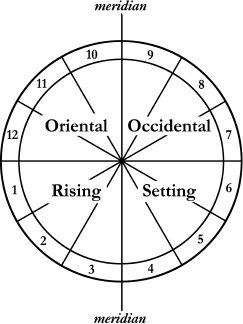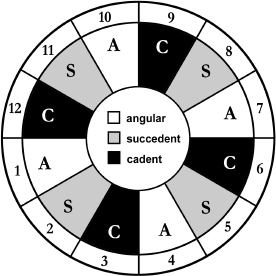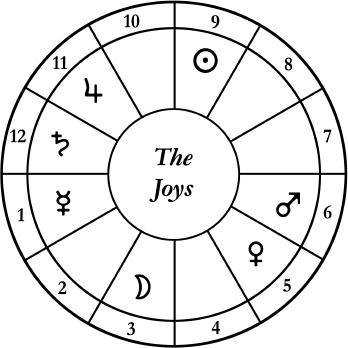
Readers new to traditional techniques may find the following account of definitions and divisions helpful. These are explored in greater detail throughout the book. Any other traditional terms employed are explained as they arise and defined in the Glossary (Appendix A) for easy reference.
The celestial sphere is divided into two hemispheres by the horizon:

Above the earth: 7th, 8th, 9th, 10th, 11th, 12th – planets in these houses are capable of being seen above the horizon. At a general level their influence is considered to be more active, forceful and outwardly expressed (or social). The 10th house, being associated with the midheaven, is particularly termed ‘above the earth’.
This hemisphere is known as the ‘diurnal hemisphere’ (diurnal meaning ‘of the quality of the day’ and being similar in principle to masculinity in suggesting a direct outpouring of energy and an expressive influence).
Under the earth: 1st, 2nd, 3rd, 4th, 5th, 6th – planets in these houses are not capable of being seen and lie beneath the horizon. At a general level their influence is more passive, subtle, hidden, and related to private experience. The 4th house, being associated with the lower midheaven, is particularly termed ‘under the earth’.
This hemisphere is known as the ‘nocturnal hemisphere’ (nocturnal meaning ‘of the quality of the night’ and being similar in principle to femininity in suggesting a retiring energy and an impressive influence).
The sphere is also divided into two hemispheres by the meridian:

Rising: 1st, 2nd, 3rd, 10th, 11th, 12th – as the celestial sphere appears to rotate around the apparently stationary viewpoint of the observer in its daily revolution, planets in these houses are rising up towards the midheaven, which represents the highest point in their daily traverse of the sky. Generally their influence is more vigorous and related to personal, self-initiated activity. The 1st house, being associated with the ascendant, is particularly termed ‘rising’.
This hemisphere is known as the ‘oriental hemisphere’ (oriental meaning ‘eastern’) because planets rise over the horizon in the east. (There is also an ‘oriental quarter’ – see below.) Being associated with newly-risen planets, the definition of planets as oriental is indicative of youth, dynamism and renewed stores of energy.
Setting: 4th, 5th, 6th, 7th, 8th, 9th – planets in these houses have passed their highest point and are now declining towards the lower midheaven, which represents the lowest point in their daily traverse of the sky. At a general level their influence is considered to be weaker, more destructive/hostile, and related to experience that involves or is instigated by someone else. The 7th house, being associated with the descendant, is particularly termed ‘setting’.
This hemisphere is known as the ‘occidental hemisphere’ (occidental meaning ‘western’) because planets set beneath the horizon in the west. (There is also an ‘occidental quarter’ – see below.) Being associated with decline and the completion of visibility, the definition of planets as occidental is indicative of ageing, lack of power and depleted energy.
The division of the celestial sphere by the horizon and meridian give four equal quadrants or ‘quarters’. Each has its own quality and ‘humour’ which unites the daily cycle of planets rising and setting over the angles with the annual cycle of the seasons and the ‘ages of man’.
The influence of the ‘quarters’ acts only as an underlay to house meanings but familiarity with the following principles will be useful when following the arguments presented in this book.

The sanguine quarter: rises from the ascendant to the midheaven, embracing the 10th, 11th and 12th house. It is termed ‘eastern’ (or oriental) because it begins with the ascendant which cuts the ecliptic in the east. It is classified as ‘masculine’ and associated with the act of rising upwards, and therefore symbolically linked to new life, active growth and projects or people in their infancy. In traditional predictive technique planets found in this quarter relate to young people or hasten the effects of timing.1 Active growth and increase are also attributed to the season of spring and the health-giving sanguine humour which equates to the element of air. In keeping with its humour this quarter is defined as ‘warming and moistening’ in the influence it imparts to the planets.
The choleric quarter: declines from midheaven to the descendant, embracing the 7th, 8th and 9th house. It is termed ‘southern’ (or meridional) because it begins with the midheaven which cuts the ecliptic in the south.2 It is classified as ‘feminine’ and although declining towards the descendant is still within the diurnal hemisphere and therefore symbolically linked to activity, open expression and the period between youth and maturity. Being associated with the full flourish of life it is related to summer and the heat-giving choleric humour which equates to the element of fire. In keeping with its humour it is defined as ‘hot and dry’.
The phlegmatic quarter: declines from the descendant to the lower midheaven, embracing the 4th, 5th and 6th house. It is termed ‘western’ (or occidental) because it begins with the descendant which cuts the ecliptic in the west. It is classified as ‘masculine’ although, being associated with the period of life that stretches from maturity to old age, it is related to autumn and the eliminating phlegmatic humour which equates to the element of water. It is thus defined as ‘cold and wet’ in influence.
The melancholic quarter: rises from the lower midheaven to the ascendant, embracing the 1st, 2nd and 3rd house. It is ‘northern’ because it begins with the IC which cuts the ecliptic in the north. It is classified as ‘feminine’ and relates to the period of old age (some say the period after death or before birth), through which it is associated with winter and the binding melancholic humour which equates to the element of earth. It is ‘cold and dry’ in influence.
From the above it can be seen that the angles are the defining influence upon the qualities attached to spatial divisions. Proximity of the houses to the angles and their classification into ‘angular’, ‘succedent’ and ‘cadent’ represents a central tenet of interpretation.

Angular houses: 1st, 4th, 7th & 10th – the most powerful houses where the influence of the planets is especially strong; so called because they are associated with the angles of the chart.
Succedent houses: 2nd, 5th, 8th & 11th – houses with an intermediate degree of strength; so called because they are rising up (and therefore succeeding) to the positions of the angular houses by the diurnal revolution of the heavenly sphere.
Cadent houses: 3rd, 6th, 9th & 12th – the least powerful houses where the influence of the planets is considered weak and exhausted; so called because they are falling away from the angles by the diurnal revolution of the heavenly sphere (the Latin term cadent means ‘falling’). That is, planets in the 3rd house have already passed through the 4th house – where their influence was effective and strong – and are now far removed from the next angle (the ascendant) which draws them towards it.
Although there are minor variations according to different authorities, the order in which the houses are said to increase the efficiency of planetary effects are as follows:
1st - 10th - 7th - 4th - 11th - 5th - 9th - 3rd - 2nd - 8th - 6th - 12th
Planets in the 1st, 10th are 7th house are therefore noticeably forceful in expression; those in the 8th, 6th or 12th house are weak.
Each of the seven visible planets is linked to a specific house where its influence is especially strong. Planets are said to ‘rejoice’ in these places because the house offers a celestial environment that is appropriate, supportative and in keeping with the natural influence of that planet.
